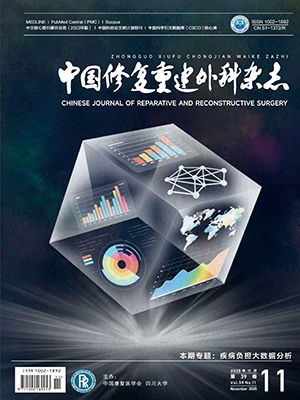| 1. |
Xia LL, Tang J, Huang SL. Primary intraspinal benign tumors treated surgically: an analysis from China. Br J Neurosurg, 2021, 35(5): 603-606.
|
| 2. |
Patel P, Mehendiratta D, Bhambhu V, et al. Clinical outcome of intradural extramedullary spinal cord tumors: A single-center retrospective analytical study. Surg Neurol Int, 2021, 12: 145. doi: 10.25259/SNI_839_2020.
|
| 3. |
Zabsonre SD, Bambara AT, Ouattara S, et al. Histological profile and progression of intraspinal tumors after surgery. Pan Afr Med J, 2021, 38: 128. doi: 10.11604/pamj.2021.38.128.21214.
|
| 4. |
洪正華, 陳偉富, 王章富, 等. 上頸椎啞鈴型腫瘤切除后骨性結構復位重建. 中華骨科雜志, 2019, 39(14): 855-862.
|
| 5. |
張宇, 李柯柯, 艾福志, 等. 頸后入路手術治療寰樞椎硬膜下髓外神經鞘膜腫瘤. 中國修復重建外科雜志, 2019, 33(12): 1480-1485.
|
| 6. |
謝京城, 陳曉東, 楊軍. 微創半椎板入路切除頸椎管內脊髓腹側腫瘤. 中國微創外科雜志, 2020, 20(9): 780-783.
|
| 7. |
Guo X, Yang S, Li Z, et al. Clinical effect of laminectomy with lateral mass screw fixation in treating cervical schwannoma: A retrospective study. Biomed Res Int, 2022, 2022: 8512374. doi: 10.1155/2022/8512374.
|
| 8. |
王旭, 劉壽坤, 袁翠華, 等. 椎板回植及纖維蛋白封閉劑在椎管內腫瘤治療中的應用. 中國修復重建外科雜志, 2008, 22(1): 122-124.
|
| 9. |
李玉偉, 王海蛟, 崔巍, 等. 超聲刮匙在頸椎前路椎間盤切除融合術中應用的安全性和有效性評價. 中華醫學雜志, 2020, 100(9): 669-673.
|
| 10. |
馬飛, 凡元和, 徐世財, 等. 后路寰樞椎固定非融合術與固定融合術治療新鮮齒狀突骨折的遠期療效比較. 中國脊柱脊髓雜志, 2021, 31(10): 877-885.
|
| 11. |
邱鋒, 許喜林, 馬向陽, 等. 枕骨板聯合C2雙側椎板螺釘交叉棒固定穩定性的生物力學研究. 中國修復重建外科雜志, 2020, 34(12): 1545-1549.
|
| 12. |
Ying GY, Yao Y, Shen F, et al. Percutaneous Endoscopic Removal of Cervical foraminal Schwannoma via interlaminar approach: A case report. Oper Neurosurg (Hagerstown), 2018, 14(1): 1-5.
|
| 13. |
孫宜保, 祝孟坤, 常曉盼, 等. 帶蒂棘突椎板韌帶復合體回植在椎管內良性腫瘤切除術中的應用. 中國實用神經疾病雜志, 2021, 24(7): 585-589.
|
| 14. |
Yu Y, Hu F, Zhang X, et al. Application of the hemi-semi-laminectomy approach in the microsurgical treatment of C2 schwannomas. J Spinal Disord Tech, 2014, 27(6): E199-E204.
|
| 15. |
姬燁, 夏景君, 徐公平, 等. 腫瘤切除頸前路鈦板輔助脊柱重建術治療上頸椎腫瘤. 中國脊柱脊髓雜志, 2015, 25(2): 186-189.
|
| 16. |
Ozawa H, Kokubun S, Aizawa T, et al. Spinal dumbbell tumors: an analysis of a series of 118 cases. J Neurosurg Spine, 2007, 7(6): 587-593.
|
| 17. |
林國中, 王振宇, 劉彬, 等. 硬膜外啞鈴形神經鞘瘤的手術治療. 中國微創外科雜志, 2018, 18(9): 783-786.
|
| 18. |
Dobran M, Paracino R, Nasi D, et al. Laminectomy versus unilateral hemilaminectomy for the removal of intraspinal Schwannoma: Experience of a single institution and review of literature. J Neurol Surg A Cent Eur Neurosurg, 2021, 82(6): 552-555.
|
| 19. |
Wang ZC, Li SZ, Qu XF, et al. Application of open-door laminoplasty with ARCH plate fixation in cervical intraspinal tumors. BMC Surg, 2021, 21(1): 141. doi: 10.1186/s12893-021-01140-3.
|
| 20. |
孫樞文, 李育平, 王曉東, 等. 椎板成形術與椎板切除術治療椎管內腫瘤臨床療效的Meta分析. 中華神經外科雜志, 2019, 35(1): 78-84.
|
| 21. |
Lei D, Zhou Y, Yao D, et al. Efficacy of unilateral hemilaminectomy for intraspinal tumor resection: a systematic review and meta-analysis. Ann Palliat Med, 2021, 10(2): 984-999.
|




